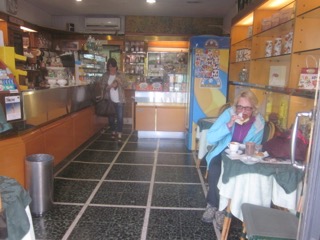We had to walk 2-3 kilometres this morning to find a bar (if I didn’t tell you before or you didn’t know) a bar sells alcohol, coffee and croissant variations. As usual, men between 40 and 70 approx. were the main guests eating and drinking their regular morning delights as we did ours.
Off through the outskirts of the famous and beautiful Lucca which we didn’t give the respect it deserves (this time). Instead we saved that respect for our ageing bodies, lying them down, carefully moving them to close by eateries then washing and oiling them, before putting them to sleep once more.
Today’s walk was without bumps and holes, simply level and mainly on roadways – tar and gravel with mostly little traffic. Three or four villages ushered us through, as we stopped in one for a fuel stop of nectarines and peaches. Two large industrial sites were the only other attractions as we poled on to our new digs for the night. With less mileage today we had time and energy to explore this one street village. We sat in the church square, surrounded by archways, turrets and towers, enjoying the novelty of an antipasti plate for lunch, comprising many more delicacies than ever encountered, and fascinated by the irregularity of the surrounding architecture. As we ate, we greeted a number of walkers from days and weeks past.
Once explored I reflected a little on our morning bar rituals and googled cappuccinos to fill the post out a little and this is what I found.
When cappucinos were first invented, they were very different from the ones you’ll find at your local bar today, and were made from coffee, sugar, egg yolks and cream. The resulting light brown shade reminded people of the hooded robes traditionally worn by Capuchin monks, so they christened the new kind of coffee ‘cappuccino’ or ‘little Capuchin’. The Capuchin monks themselves got their names from their hoods (the Italian word for hood, ‘cappuccio’, comes from the Latin ‘caputium’) which were long, pointed and brown, inspired by Francis of Assisi’s clothes of poverty.
But when it comes to the drink, an even bigger shock is that the cappuccino didn’t even originate in Italy – there is no evidence for it existing on the peninsular until the 20th century (when the invention of fridges allowed them to swap the egg and cream for milk), however the early forms of the beverage were attested in Austria as a ‘kapuziner’ two hundred years earlier. The traditional version of the ‘kapuziner’ can still be found in Austrian cafes, with just a drop of cream, while the Austrians have re-adopted the Italian term cappuccino for the milkier version.

